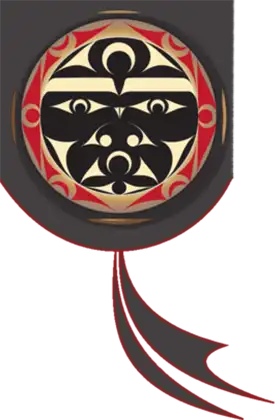Family Activity – All about Tulalip

This lesson supports our connections to Tulalip by practicing how we introduce ourselves to each other and in community gatherings.
Introductions
All About Tulalip Unit
In this unit children become familiar with the lands and waters of Tulalip and build their identity within the Tulalip Tribes. It establishes the relationship between people, culture, and rights that were secured by the treaty.
Lushootseed
gʷat kʷi adsdaʔ – What’s your name?
___ ti dsdaʔ./ ___ tsi dsdaʔ – My name is ___.
čad kʷi adsʔəsɬaɬlil – Where do you live?
gʷat kʷi ad____ (kayə, scapaʔ, skʷ̓ uy, bad) – Who is your ____? (grandma, grandpa, mom, dad)
sduhubš čəd čəda sdukʷalbixʷ tul̕ʔal ti dxʷlilap. – I am Snohomish and Snoqualmie from Tulalip.
Activity Instructions

• Talk with your children about who their family members are. This should include the family they live with and other family members that live outside the home.
• Talk with children about the elders in their family and why it is important to know who their relatives are.
• Listen to the example introduction provided in the activity, repeating as needed.
• Practice saying your introduction and help your children say their introductions.
• Encourage all family members to practice their introductions. Help each other as you learn and practice the lines and pronunciation!
• Ask each other different questions to support your introductions:
gʷat kʷi adsdaʔ What’s your name?
čad kʷi adsʔəsɬaɬlil Where do you live?
gʷat kʷi ad____ (kayəʔ, scapaʔ, skʷ̓ uy, bad) Who is your ____? (grandma, grandpa, mom, dad)
Family and intergenerational learning
This activity would be great for including Elders and Children, for getting to know a little more about one’s own family history.
Local Place Connections
Learning more about your family and how you introduce yourself are good ties into learning more about the Language and the land.
huyadadčəɬ:
To be able to share who you are, in your Traditional Language is a great gift to pass along to your families.

This activity will have families go
visit some interesting landmarks
around Tulalip. While many places
will be familiar to some, they may
be new to those who’ve never been
or Elders who hadn’t visited in a
while. Our goal is to have students
and families see more of their
traditional home.
Places of Interest
All about Tulalip Unit
In this unit children become familiar with the lands and waters of Tulalip and build their identity within the Tulalip Tribes. It establishes the relationship between people, culture, and rights that were secured by the treaty.
Lushootseed
stab čəxʷ ʔəsšudxʷ – What do you see?
ʔəsšudxʷ čəd ti ______. – I see ________
dəxʷʔəɬəd – Dining Hall
qʷəl̕sidəʔ dᶻəɬixʷ – Quil Ceda Creek
luƛ̕təd – Elders
dxʷlilap – Tulalip
sduhubš – Snohomish
swatixʷtəd – Land
x̌ʷəlč – Ocean
tliti – Treaty
stuləkʷ – River
dᶻəɬixʷ – Creek
sbadil – Mountain
Activity Instructions
• This activity will require the ʔiišəd (family) to travel to ləliʔ (different) locations like dəxʷʔəɬəd (Dining Hall/ Old Montessori), dxʷdigʷitəgʷəlalʔtxʷ (Admin), and qʷəl̕sidəʔ dᶻəɬixʷ (Quil Ceda Creek).
• These locations are very important places, modern and traditional.
• Visit these places and look and walk around the area, many have signs about the history around them.
• Have Elders and other family members share stories about other experiences they remember at these places.

Family and intergenerational learning
Elders can provide insight on past experiences and gift that knowledge to younger family.
Local Place Connections
By visiting these places, we remember the important things that occurred around our traditional home, we keep all that history in our x̌əč (mind).
huyadadčəɬ:
We must always remember to care for the land, our traditional home.

Hibulb Family Tree
All about Tulalip Unit
In this unit children become familiar with the lands and waters of Tulalip and build their identity within the Tulalip Tribes. It establishes the relationship between people, culture, and rights that were secured by the treaty.
Lushootseed
dxʷlilap – Tulalip
sduhubš – Snohomish
swatixʷtəd – Land
x̌ʷəlč – Ocean
tliti – Treaty
stuləkʷ – River
dᶻəɬixʷ – Creek
sbadil – Mountain
sk̓ʷuy – Mother
bad – Father
ʔəpus – Aunt
qəsiʔ – Uncle
kayə – Grandmother
scapaʔ – Grandfather
ʔəslax̌dxʷ čəxʷ ʔu – Do you remember them?
ʔi, ʔəslax̌dxʷ čəd – Yes, I remember them.
xʷiʔ, xʷiʔ gʷədsʔəslax̌dxʷ – No, I don’t remember them.
__ tsi/ti sdaʔs – Their name is __. (tsi=feminine, ti = masculine)
Activity Instructions
• Make sure you know your Tulalip Tribal ID number; the kiosk will ask for that to help with its search.
• Go to Hibulb, visit the main gallery and locate the Family Tree kiosk, use your info to search for your family tree.
• As a family, share stories of the ancestors in your family tree. You can ask “ʔəslax̌dxʷ čəxʷ ʔu (Do you remember them?)” And answer, “ʔi, ʔəslax̌dxʷ čəd (Yes, I know them) or “xʷiʔ, xʷiʔ gʷədsʔəslax̌dxʷ (No, I don’t remember them)”.
• You can also use this opportunity to ask other elders and community members more about your family that you would like to learn.
Family and intergenerational learning
Children can have a hands-on experience and visual experience with their past family, Elders can share interesting information they have on past family too.
Local Place Connections
Visiting our museum and seeing one’s own family displayed with members of past family can further show our longstanding connection with the land.
huyadadčəɬ:
Just like looking at the Point Elliott Treaty, you can see important people who helped bring our people this far in the world.



